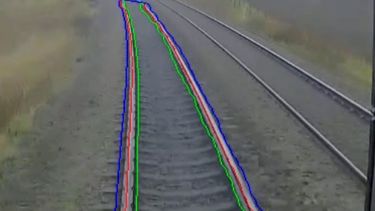Measuring train motion and predicting faults with an onboard camera
In this project we use the forward facing cameras onboard trains to measure how the train moves relative to the tracks, creating a 3D map of the tracks ahead. By measuring how the train moves we can predict what is a normal movement, or what is abnormal, and possible due to a track or train fault.

Project aim We aim to use an onboard camera, pointing at the tracks, to determine how the train has moved relative to the tracks, and reconstruct a 3D map of the track position. By piecing together how the train moved in each frame, a map of the track, and train speed, we aim to predict whether the train motion is due to a defect (in the track or suspension) or whether it is normal movement.
Background The motion of trains is guided by the interaction of train wheels with the rails. Misalignment or wearing of the rails causes unwanted forces to be transferred to the train. In extreme cases, these can cause derailment of the train with potentially major health & safety and economic consequences. In less severe cases, these forces are transferred through the vehicle suspension and are perceived as unpleasant ‘rough rides’ by staff or passengers in the body of the train.
Track maintenance To maintain safety and ride quality, Network Rail (NR) measures the condition of the track against specified geometry targets including for alignment (‘line’), vertical (‘top’), twist, gauge and cant. It takes appropriate action where the condition has deteriorated. In severe cases, this will include the imposition of speed restrictions or line blocks until the fault is fixed. This system will ideally replace driver reported rough rides, and is easily scalable as most trains already have a forward facing security camera.
NR uses a fleet of dedicated recording vehicles to measure track condition under load or ‘dynamic’ conditions. The frequency of inspection depends on the risk, with the busiest and highest speed routes being checked every fortnight. In areas of low risk not visited by the track recording fleet, static or manual measurements are undertaken.
Rough ride reports Track faults can occur between routine inspections, due, for example. to earthwork failures, battered rail joints, voiding sleepers or deliberate acts of vandalism. As a second line of defence, NR rely on rough ride conditions reported by drivers, train crew or members of the public, to detect possible faults. Usually the rough ride is reported by the driver to the signaller, hence the term ‘Driver Reported Rough Rides’ (DRRRs).
In response to a DRRR, the signaller will inform track maintenance staff who will attend to the possible fault. Typically, there will be an impact of train running, e.g. through speed restrictions, until the fault is cleared.
The challenge is therefore to prevent service affecting DRRRs from occurring by identifying and addressing precursor DRRR conditions before they result in a driver report.
